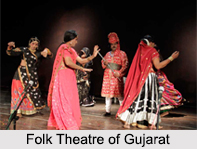 Folk Theatre of Gujarat is a composite art form in India with a fusion of elements from music, dance, pantomime, versification, epic and ballad recitation, graphic and plastic arts, religion and festival peasantry. Besides providing mass entertainment, it helps the society as indigenous tools of interpersonal, inter-group and inter-village communication for ages. Folk theatre has been used extensively in India to propagate critical social, political and cultural issues in the form of theatrical messages to create awareness among the people. As an indigenous form it breaks all kinds of formal barriers of human communication and appeals directly to the people.
Folk Theatre of Gujarat is a composite art form in India with a fusion of elements from music, dance, pantomime, versification, epic and ballad recitation, graphic and plastic arts, religion and festival peasantry. Besides providing mass entertainment, it helps the society as indigenous tools of interpersonal, inter-group and inter-village communication for ages. Folk theatre has been used extensively in India to propagate critical social, political and cultural issues in the form of theatrical messages to create awareness among the people. As an indigenous form it breaks all kinds of formal barriers of human communication and appeals directly to the people.
Types of Folk Theatre in Gujarat
Indian folk theatre is a mixture of song, dance and dialogue. Indian folk theatre varies from region to region. Each Indian folk theatre performance is a unique reflection of the regional culture, its values, and its peoples. Some forms of Indian folk theatre are still performed today, but only on special occasions in some rural villages of Gujarat.
Bhavai: Bhavai is a form of folk theatre that is popular in Gujarat. The main theme of Bhavai plays features the suffering of the lower castes. Bhavai performances were staged in open grounds before the farmers and all other community audiences who would come for entertainment after the day"s tiring labour in their farms and shops etc. The Bhavai performers were called Bhavaiya.
Akhyana: Akhyana was a traditional musical theatre as well as medieval genre of Gujarati poetry. Akhyanas are mostly stories of kings or holy men that have formed the basis of epics and puranas. Akhyanas are often found in Vedic literature, as stories narrated to kings during sacrifices. The narrator or professional story tellers who recited Akhyanas were called "Manabhatt" or "Gagaria-bhatt". All Akhyana ends with happy note and its length varied greatly. This theatre form continued to decline thereafter and became almost extinct by 19th century.
Folk Theatre of Gujarat accorded much prominence to songs and music. Special trains would be arranged for taking spectators from the neighbouring towns and villages to the places where dramas were being performed. The dramas would be presented in spectacular fashion with colourful backdrop screens, fancy costumes and awe-inspiring stage techniques.




















